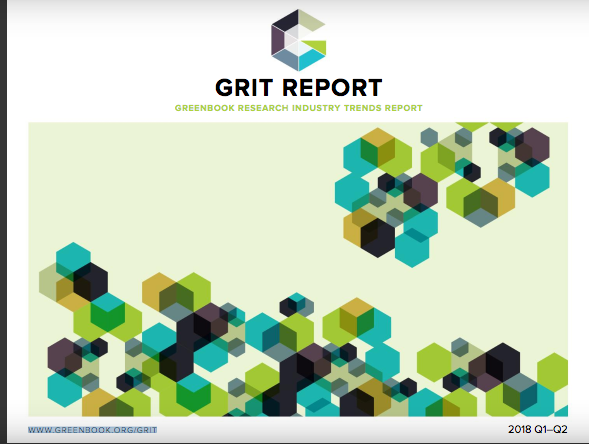
Why is the new GreenBook Research Industry Trends (GRIT) Report different from all others that have come before it?
It’s different because it's the first to include the magic words that will save market research: “Mobile in-app solutions.”
Here’s the full quote, from an anonymous respondent to GreenBook’s survey of 3,930 global respondents (49% of them from the U.S.):
“Mobile in-app solutions provide for more accurate, reliable and representative sample. As market research suppliers start to adopt this gold standard of data collection, sample and the data output will become better.”
It was one of the few confidently positive assertions in a chapter titled “The Future of Sampling.” That future will be bleak, the report says, unless the industry can find answers to the problems that are rapidly eroding trust in survey data. At the heart of the crisis is consumers’ disengagement from participating in survey research.
Here's how GRIT's authors sum up the situation: “The frustrations from all sides [of the data-quality crisis] are real, and the risks are growing….The traditional model is no longer sustainable and will require painful change up and down the survey ecosystem.”
To quantify the data quality problem:
- The GRIT survey found that 39% of the clients and researchers who depend on outside sample providers expect the quality of consumer panels to worsen over the coming three years. Only 19% thought it would improve.
- Tellingly, 23% of sample providers think their product’s quality will worsen, and 37% expect quality to stay the same.
- That’s a shocking 60% who think the quality of what they sell is moving in the wrong direction. And in today’s fast-shifting landscape for just about any industry, those who stand still are going to get run over by those who are innovating to move ahead.
Another quoted GRIT respondent summed it up without mincing words:
“[I am] completely frustrated with the quality of sample now and have no confidence that the panel companies will do anything to improve it. Frankly, it’s a slimy business and if clients knew half of what goes on behind the scenes, a lot of online research would go away.”
Again, GRIT points to mobile surveys as the way forward:
- “Surveys taken on mobile devices offer many more methods of validating respondent identity and location,” a key defense against the rampant data fraud that is rapidly eroding confidence in traditional online surveys.
- "[It] will get better only if the medium changes. Mobile-first sample introduces higher quality data at larger scale vs. traditional online panels, because Mobile Ad IDs are harder to ‘dupe’ than online cookies." An Ad ID is the unique, validating code that identifies each smartphone.
But remember: the magic words that will redefine consumer data collection are not "mobile solutions." They are "mobile in-app solutions." There's a critical distinction between accessing a universe of first-party consumers who have downloaded an app through which they can participate in market research, versus continuing to conduct online surveys, but trying to make them more palatable to smartphone users. You've seen this less innovative approach described as "mobile optimized," "mobile friendly," "mobile first" or "mobile web."
Only "mobile web" is a legitimate label, because it specifies an actual research technique: fielding online, web-based surveys to consumers on their smartphones. Using the right terminology clarifies the choice market researchers have to make, once they decide they need to emphasize mobile, and realize that they need to get it right.
When making that choice, here are key points to consider:
- Apps, rather than mobile web, are the natural, preferred mobile environment.
- Proof point: U.S. adult smartphone owners’ average daily mobile app usage exceeded mobile web usage by a ratio of nearly 6 to 1 in 2017 – 145 minutes for apps, and 26 minutes for mobile web. (per eMarketer).
- When the interface is an advanced mobile app, surveys load instantly into the respondents' phones. They can now answer when it's convenient, with no need for the continuous connection to the internet that's necessary for mobile-web methodology.
You've probably experienced the difference between mobile apps and mobile web yourself. To spell it out:
- Access to any kind of content via a web browser is vulnerable to interruptions due to poor connectivity.
- Mobile web/mobile browser connections are vulnerable to load times that are far longer than the one or two seconds experts say is all consumers will tolerate before moving on to something else.
- For surveys, each question and answer requires a back-and-forth exchange between the respondent's phone and the internet-based survey host.
- Slow load time performance and dropped connections leave mobile survey-takers frustrated and alienated, perpetuating the mounting problem of consumers refusing to participate in surveys at all.
There’s a lot here to digest, but it comes down to one overarching distinction that consumer insights professionals must keep in mind:
There’s no such thing as “mobile methodology” because that would suggest there are other meaningful research methodologies. Today, we all live in a mobile ecosystem. And within that ecosystem, you must choose where to live and conduct your work: inside the safety of a mobile app, or out there, exposed, on the hazardous mobile web.
Thanks as always to GreenBook for keeping a steady hand on the pulse of the consumer insights profession and giving us an ongoing reading of its hopes, fears and best ideas about finding ways forward. This time, the report has gone a long way toward clarifying the problem, and pointing specifically to mobile in-app solutions as the way forward.
You’ll find more about in-app mobile on the MFour blog, and you’ll access the largest repository of in-app mobile solutions on the MFour website,. including an archive of webinars. And to set up a discussion about how in-app mobile research will address your specific needs, just get in touch by clicking here.



